The AMD Trinity Review (A10-4600M): A New Hope
by Jarred Walton on May 15, 2012 12:00 AM ESTAMD Trinity Gaming Performance
After the 3DMark results, you might be wondering if Intel has finally caught up to AMD in terms of integrated graphics performance. The answer is…yes and no. Depending on the game, there are times where a fast Ivy Bridge CPU with HD 4000 will actually beat out Trinity; there are also times where Intel’s IGP really struggles to keep pace. The good news is that at least everyone is now onboard the DX11 bandwagon, and compatibility with games has improved yet again for Intel. Here are our “Value” benchmark results for seven recent games; we’ll have more information in a moment.

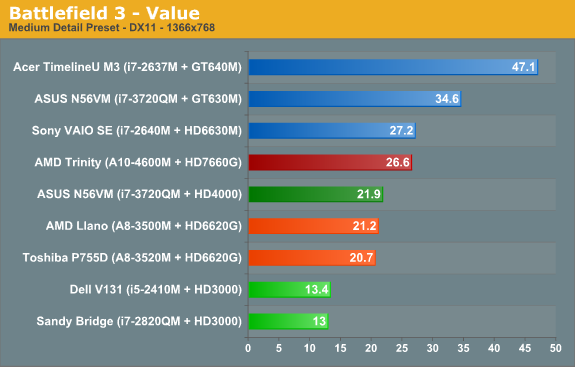
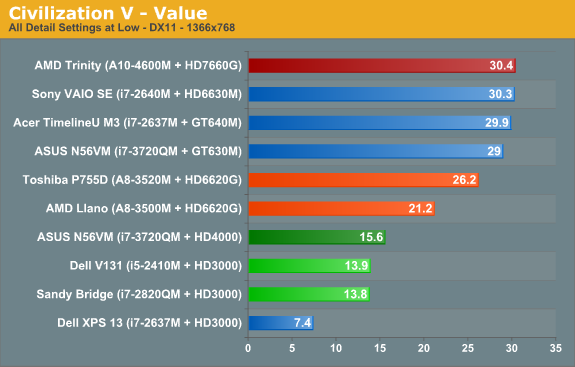

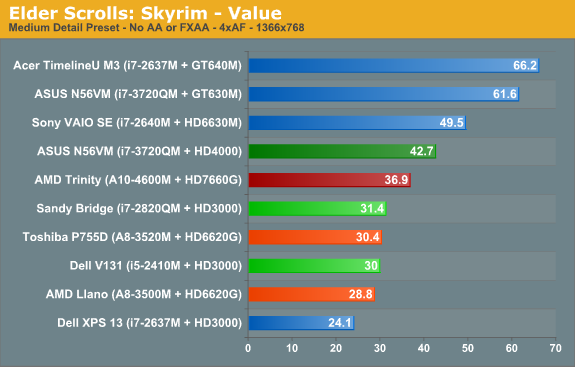
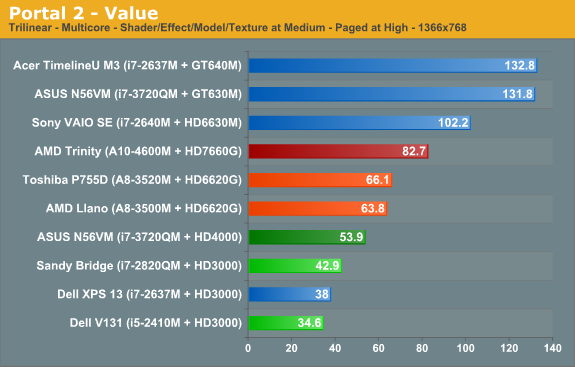
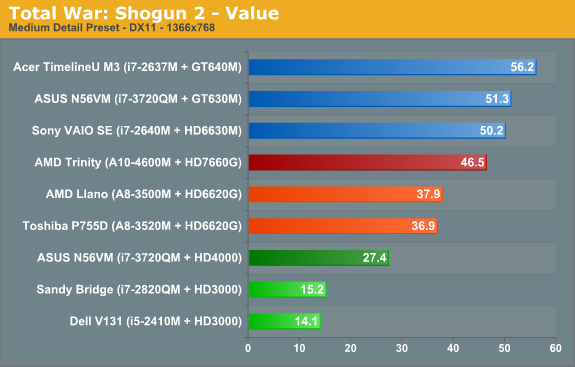
Out of our seven test titles, AMD’s Trinity leads any other IGP in four titles by a large margin. The other three titles actually have Ivy Bridge slightly ahead of Trinity, but the gaps aren’t nearly as big. Overall, the average performance across the seven games at our Value (medium) settings has AMD’s Trinity A10-4600M leading Intel’s i7-3720QM by 21%, and if we look at quad-core Sandy Bridge with HD 3000 (i7-2820QM) Trinity is 72% faster. Trinity is also around 20% faster than 35W Llano on average.
Let’s expand our gaming suite just a bit to see if things change, though. Just like we did with Ivy Bridge, we ran the eight games in our previous benchmark suite at medium detail settings. We can then compare performance across a wider 15 title selection to see how Trinity matches up against HD 4000, HD 3000, and HD 6620G (Llano). We’ll start with the bottom (HD 3000/Sandy Bridge) and move up.
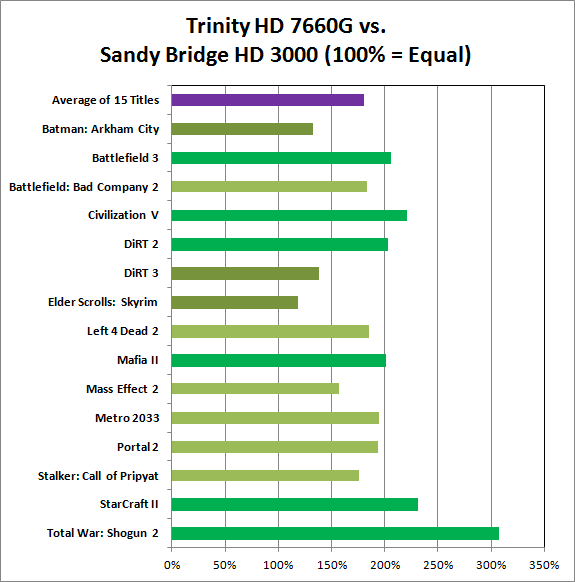
Llano’s HD 6620G was already faster than HD 3000, and Trinity’s HD 7660G is faster than Llano, so the Sandy Bridge gaming matchup is a landslide victory in AMD’s favor. The closest Intel can get is in the same three titles where Ivy Bridge leads Trinity: Batman: Arkham City, DiRT 3, and Skyrim. Here, however, HD 3000 can’t actually close the gap and HD 6620G is at least 20% faster than HD 3000, with an average performance improvement of nearly 80%.
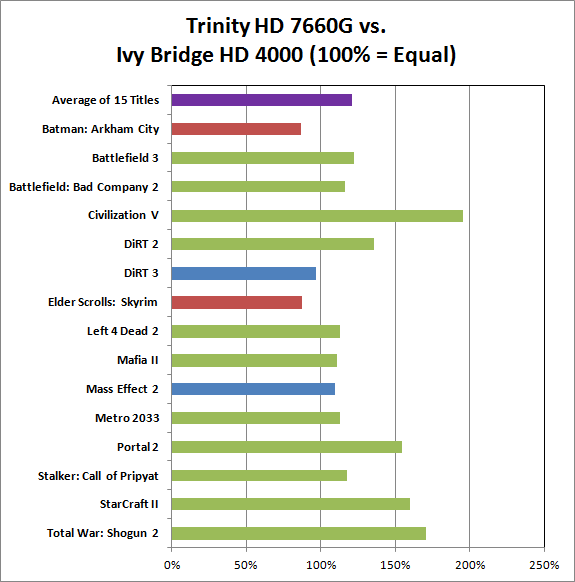
We found that across the same selection of 15 titles, Ivy Bridge and Llano actually ended up “tied”—Intel led in some games, AMD in others, but on average the two IGPs offered similar performance. This chart and the next chart will thus show a similar average increase in performance for Trinity, but the details in specific games are going to be different. Starting with Ivy Bridge and HD 4000, as with our earlier game charts we see there are some titles where Intel leads (Batman and Skyrim), a couple ties (DiRT 3 and Mass Effect 2), and the remainder of the games are faster on Trinity. Mafia II is close to our <10% “tie” range but comes in just above that mark, as do Left 4 Dead 2 and Metro 2033. The biggest gap is Civilization V, where Intel’s various IGPs have never managed good performance; Trinity is nearly twice as fast as Ivy Bridge in that title. Overall, it's a 20% lead for Trinity vs. quad-core Ivy Bridge.
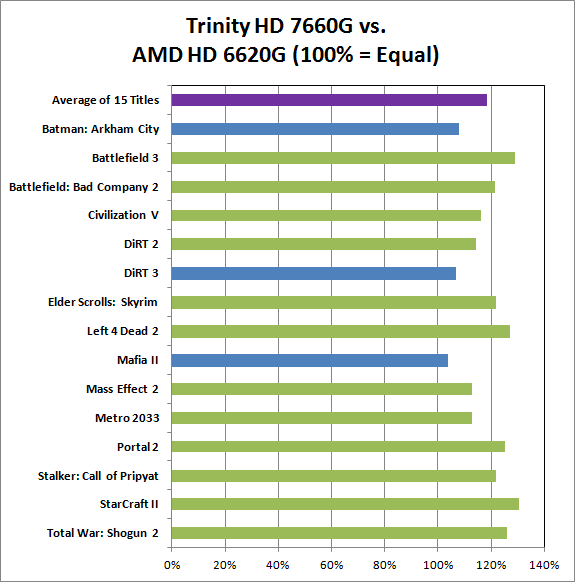
Against Llano, Trinity is universally faster, but the smallest gap is in Mafia II (3%) while the largest gap is in StarCraft II (30%). On average, looking at these games Trinity is only 18% faster than Llano. What’s not entirely clear from the above chart is whether we’re hitting CPU limitations, memory bandwidth limitations (remember that Llano and Trinity share bandwidth with the rest of the system), or perhaps both. At our chosen settings, what is clear is that Trinity’s “up to 56% faster” graphics never make it that high.
We saw 35-45% higher scores in 3DMark 11 and Vantage, which tend to remove the CPU from the equation more than actual games, so our guess would be that if AMD continues with their APU plan they’re going to need to work more on the CPU side of the equation. We also see the same thing looking at the VAIO SE scores in the earlier gaming charts: the HD 6630M scores are 20% faster on average, but much of that appears to come from the faster CPU rather than the GPU.










271 Comments
View All Comments
AlB80 - Tuesday, May 15, 2012 - link
No.It's official information.
JarredWalton - Tuesday, May 15, 2012 - link
Except according to CLInfo, it does. Nice try?AlB80 - Tuesday, May 15, 2012 - link
Oops. It was.Now it has fp64 = 1/16 fp32.
princehamlet - Tuesday, May 15, 2012 - link
I was constantly refreshing the page at 12 AM! Couldn't wait for the reviews to be posted after the embargo was lifted :D.BSMonitor - Tuesday, May 15, 2012 - link
Why? Nothing earthshattering here. AMD is scalping resources from the CPU to add TDP room and die space for more of it's bulky Radeon shaders.It's like buying a laptop from 2004, with a DX11 upgrade.
AMD has the "good enough" part backwards. People want their laptop to be responsive when doing work, watching movies and browsing, etc. CPU intensive tasks. The good enough part, in regards to laptops would be the gaming. No one expects 60fps at 1080 out of laptop sitting on a plane flying somewhere.
Way to capture the hearts of the 1% of the 1% of people looking for great gaming from their $500 laptop.
Articuno - Tuesday, May 15, 2012 - link
Considering the CPU part is better than mobile Core 2 Duo parts (and thousands upon thousands of people are still using laptops with C2Ds) and the GPU part is several orders of magnitude better than Intel's best, I'd say buying an Intel laptop is like buying a laptop from 2004: expensive and extremely low price/performance for what you get.JarredWalton - Tuesday, May 15, 2012 - link
Whoa... several orders of magnitude? So, like, 1000X better? Because if anyone can offer up a GPU that's 1000 times faster than even GMA 4500, I'd take it! Turning down the hyperbole dial: AMD still has better drivers than Intel, but it's more like 20% better (just to grab a nice number out of thin air). Trinity's GPU is about 20% faster than HD 4000 as well, so that makes Trinity's GPU a whopping 44% better than "Intel's best".Now if you want to talk about the best Core 2 era IGP, then we'd be looking at more like an order of magnitude improvement. GMA 4500MHD scores around 1000 in 3DMark06, in case you were wondering (http://www.anandtech.com/show/2818/6). I know, it's only 3DMark -- still, call it 500 as a penalty for lousy drivers and HD 7660G is still "only" about 20X better.
/meaningless debate
Articuno - Tuesday, May 15, 2012 - link
Fair enough, kind of a knee-jerk reaction out of me there. Though I'm guessing the APU will be cheaper than the i7s it's going up against even without a discrete card added on top of them, so it's got very nice price/performance potential.jensend - Tuesday, May 15, 2012 - link
Yes, his "orders of magnitude" was hyperbole- but Intel's benchmark scores esp 3dmark really haven't reflected how awful their GPUs have been. The performance difference in real games was usually much bigger than that in synthetic benchmarks. You already mentioned driver issues. Even if you could get halfway decent performance out of some games, image quality was often a huge problem. If AMD or nV had offered that crappy of image quality they would have been totally excoriated in the press for cheating in order to inflate benchmarks; people didn't do that to Intel- probably because it would have felt like beating a handicapped child.But Sandy had some real improvements and then Ivy Bridge really turned things around for Intel. Beyond the performance improvements, after years of making excuses for their AF and saying that AA was unnecessary, they finally stopped making excuses and fixed them. Trinity is faster, but anybody who says that Ivy Bridge's graphics don't offer Trinity's any competition is badly mistaken.
Spunjji - Tuesday, May 15, 2012 - link
Indeed - I was honestly pleasantly surprised to see HD4000 sitting so high in the charts. Finally I won't need to start warning people against Intel notebooks!...except for the small problem of HD2500. Still, improvement is improvement.